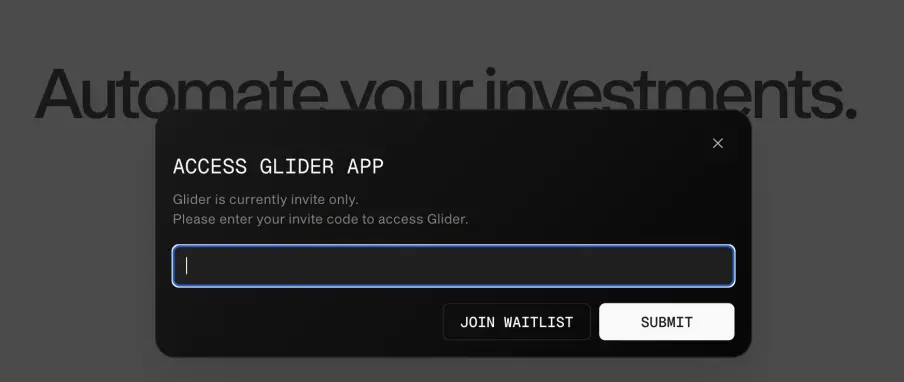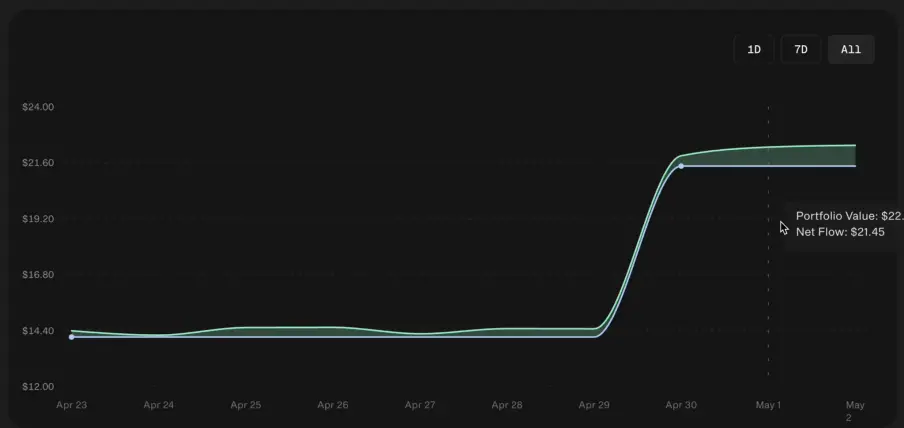Author: Patti, ChainCatcher
Editor: TB, ChainCatcher
The on-chain trading platform Glider is quietly rising.
Recently, Glider completed a $4 million financing round led by a16z CSX, with participation from investment institutions such as Coinbase Ventures, Uniswap Ventures, and GSR. This strong financing lineup has attracted the attention of the crypto community and sparked widespread interest in the on-chain asset management sector, with Glider's popularity continuing to climb.
Pain Points in On-Chain Asset Management
In traditional financial asset management institutions, firms like Bitwise and Grayscale typically adopt a custodial model, where user assets are managed centrally by the institution. Glider believes that while traditional asset management institutions provide professional management services to some extent, they also sacrifice users' autonomy over their assets.
Glider co-founder Brian Huang has stated that what sets Glider apart is that it will not hold users' assets in a custodial manner like traditional finance, and this will be achieved through blockchain technology.
However, even on-chain, portfolio management faces numerous challenges:
High technical complexity threshold: In a multi-chain ecosystem, the heterogeneity of gas tokens, the latency risks of cross-chain bridging, and the real-time requirements of rebalancing strategies make manual operations extremely difficult in responding to market fluctuations.
Severe infrastructure fragmentation: There is a lack of standardized interfaces between DeFi protocols, requiring users to frequently switch between AMMs, lending protocols, and options platforms.
Asymmetry of returns and risks: Retail investors often fall into the trap of "strategy becomes ineffective once public" during the strategy replication process, while professional institutions build advantages through quantitative models, leading to a situation where a few individuals control most of the on-chain returns.
In response to these issues, Glider has proposed a new concept based on balancing automated execution and user control.
Intent-Driven Modular System
Glider co-founder John Johnson stated that the creation of Glider stemmed from frustration with the fragmented infrastructure that has long plagued cryptocurrency portfolios, and Glider was born to completely eliminate this friction, achieving precise and automated execution across networks.
The core idea is to build "middleware" for on-chain asset management, decoupling strategy formulation, execution, and risk control into programmable modules. Users can configure parameters according to their needs or choose from smart templates provided by the platform.
The core of Glider's product is an intent-driven modular architecture. Users only need to set investment goals and strategy intentions, and the underlying chain abstraction technology will automatically complete cross-chain operations, asset adjustments, and trade executions, reducing the burden of manual operations.
Glider's tech stack adopts a modular design, with the following specific features:
Portfolio Construction
Users can use intuitive asset allocation tools or selected templates to customize investment strategies.
Automated Execution
Glider will seek liquidity across different chains and manage rebalancing to trigger trades. When market conditions change, the system can automatically execute preset strategies.
Non-Custodial Integration
Users can connect any existing wallet (such as MetaMask, Rainbow, Safe, WalletConnect, etc.) without needing a new mnemonic phrase.
Integrated Lending
Glider automatically borrows through trusted DeFi lending protocols like AAVE to optimize returns. Users can utilize their assets for lending operations without transferring asset ownership, gaining additional earning opportunities.
Collaborative Investment
Users can share strategies and customize them, continuously optimizing their portfolios.
Integrated Backtesting
Users can test strategies using historical data on the Glider interface and compare performance against BTC, ETH, and other benchmarks. The backtesting feature allows users to understand strategy performance in advance.
Team Background
From the currently disclosed information about the founding team, the main members are Brian Huang and John Johnson.
As co-founders, Brian Huang and John Johnson have impressive backgrounds, having worked at well-known institutions such as Anchorage Digital, XTX Markets, 0x, and Matcha. Other team members also come from industry-leading companies like Coinbase, MetaMask, 0x, Cega, and PoolTogether.
Brian Huang holds a Ph.D. in Computer Science from MIT and previously served as the Chief Architect at Anchorage Digital, leading the development of a cross-chain custody system that supports over 20 public chains.
John Johnson, as an early core developer of the 0x protocol, led the reconstruction project of the Matcha aggregation trading engine, which set an industry record with a daily trading volume of $1.2 billion.
Conclusion
Currently, Glider is still in technical testing, with plans to launch the product in the coming months.
According to the official website, the product is currently invite-only, and the waitlist is open.

Additionally, according to Glider builder @marcos_0x, more features are currently under development. Currently, Glider can display the current value of users' portfolios and net flow (a key visualization clue for understanding investment performance).

Furthermore, according to their official disclosure, they plan to profit by charging users a management fee based on a percentage of their managed asset size.
As the cryptocurrency industry evolves from "financial experiments" to "value networks," true decentralization should not come at the expense of user experience but should be achieved through technological innovation that internalizes complexity.
Co-founder John Johnson has stated, "Everyone should be able to precisely adjust their portfolios according to their wishes, automate processes, and invest freely within their risk tolerance and preferences."
Perhaps only when on-chain asset management becomes as simple and user-friendly as traditional financial ETFs can DeFi hope to transition from a geek toy to mainstream financial infrastructure.
Glider is making new attempts in the field of on-chain asset management.
免责声明:本文章仅代表作者个人观点,不代表本平台的立场和观点。本文章仅供信息分享,不构成对任何人的任何投资建议。用户与作者之间的任何争议,与本平台无关。如网页中刊载的文章或图片涉及侵权,请提供相关的权利证明和身份证明发送邮件到support@aicoin.com,本平台相关工作人员将会进行核查。




